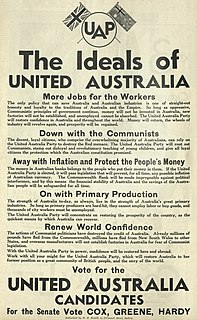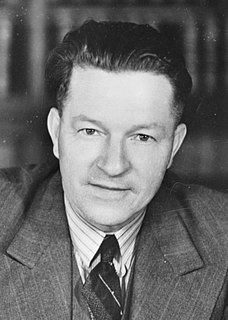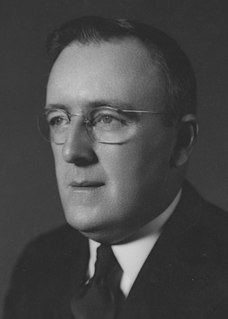
The United Australia Party (UAP) was an Australian political party that was founded in 1931 and dissolved in 1945. The party won four federal elections in that time, usually governing in coalition with the Country Party. It provided two Prime Ministers of Australia – Joseph Lyons (1932–1939) and Robert Menzies (1939–1941).

John Curtin was an Australian politician who served as the 14th Prime Minister of Australia from 1941 until his death in 1945. He led the country for the majority of World War II, including all but the last few weeks of the war in the Pacific. He was the leader of the Australian Labor Party (ALP) from 1935 to 1945, and its longest serving leader until Gough Whitlam. Curtin's leadership skills and personal character were acclaimed by his political contemporaries. He is frequently cited as one of Australia's greatest prime ministers, and is the only prime minister to represent a constituency in Western Australia.

Francis Michael Forde was an Australian politician who served as Prime Minister of Australia from 6 to 13 July 1945. He held office after the death of John Curtin, and is the shortest-serving prime minister in Australia's history.

Sir Paul Meernaa Caedwalla Hasluck, was an Australian statesman who served as the 17th Governor-General of Australia, in office from 1969 to 1974. Prior to that, he was a Liberal Party politician, holding ministerial office continuously from 1951 to 1969.
A war cabinet is a committee formed by a government in a time of war. It is usually a subset of the full executive cabinet of ministers. It is also quite common for a war cabinet to have senior military officers and opposition politicians as members.

Edward John Ward was an Australian politician who represented the Australian Labor Party (ALP) in federal parliament for over 30 years. He was the member for East Sydney for all but six-and-a-half weeks from 1931 until his death in 1963. He served as a minister in the Curtin and Chifley Governments from 1941 to 1949, and was also known for his role in the ALP split of 1931.

Sir George Foster Pearce KCVO was an Australian politician who served as a Senator for Western Australia from 1901 to 1938. He began his career in the Labor Party but later joined the National Labor Party, the Nationalist Party, and the United Australia Party; he served as a cabinet minister under prime ministers from all four parties.

The Division of Curtin is an Australian electoral division in Western Australia.

The "Brisbane Line" was a defence proposal supposedly formulated during World War II to concede the northern portion of the Australian continent in the event of an invasion by the Japanese. Although a plan to prioritise defence in the vital industrial regions between Brisbane and Melbourne in the event of invasion had been proposed in February 1942, it was rejected by Labor Prime Minister John Curtin and the Australian War Cabinet. An incomplete understanding of this proposal and other planned responses to invasion led Labor minister Eddie Ward to publicly allege that the previous government had planned to abandon most of northern Australia to the Japanese.

Lang Labor was a faction of the Australian Labor Party (ALP) consisting of the supporters of Jack Lang, who served two terms as Premier of New South Wales and was the party's state leader from 1923 to 1939.

John Albert Beasley was an Australian politician who was a member of the House of Representatives from 1928 to 1946. He served in the Australian War Cabinet from 1941 to 1946, and was a government minister in the Curtin and Chifley Governments. Beasley was a member of the Australian Labor Party, although on two occasions he left the party to join the breakaway Lang Labor groups, leading the faction in federal parliament. He concluded his career as High Commissioner to the United Kingdom from 1946 until his death in 1949.
The Defence Act (1943) was federal Australian law passed on 26 January 1943 which extended the area in which the Militia were obliged to serve from Australia and its territories to the South-Western Pacific Zone (SWPZ), a triangle bounded by the equator and the 110th and 159th meridians of longitude, for the duration of the war and up to six months of Australia ceasing to be involved in hostilities.
The Australian Labor Party (Non-Communist) was a breakaway from the Australian Labor Party (ALP) associated with the Lang Labor faction and former New South Wales premier Jack Lang, operating from 1940 to 1941.

The 1940 Australian federal election was held in Australia on 21 September 1940. All 74 seats in the House of Representatives and 19 of the 36 seats in the Senate were up for election. The incumbent Coalition, consisting of the United Australia Party led by Prime Minister Robert Menzies and the Country Party led by Archie Cameron, defeated the opposition Labor Party under John Curtin despite losing the overall popular vote.

Although most Australian civilians lived far from the front line of World War II, the Australian home front during World War II played a significant role in the Allied victory and led to permanent changes to Australian society.
This is a list of the members of the Australian House of Representatives in the 17th Australian Parliament, which was elected at the 1943 election on 21 August 1943. The incumbent Australian Labor Party led by Prime Minister of Australia John Curtin defeated the opposition Country Party led by Arthur Fadden with coalition partner the United Australia Party (UAP) led by Billy Hughes. On 21 February 1945, the parliamentary UAP was dissolved and replaced by the newly established Liberal Party.

The Curtin Government was the federal executive government of Australia led by Prime Minister John Curtin. It was made up of members of the Australian Labor Party in the Australian Parliament from 1941 to 1945.

The Menzies Government (1939–1941) refers to the federal executive government of Australia led by Prime Minister Robert Menzies. Menzies led the United Australia Party in the Australian Parliament from 1939–1941. Menzies served a later and longer term as Prime Minister as leader of a successor party, the Liberal Party of Australia from 1949–1966.

The Lyons Government was the federal Executive Government of Australia led by Prime Minister Joseph Lyons. It was made up of members of the United Australia Party in the Australian Parliament from January 1932 until the death of Joseph Lyons in 1939. Lyons negotiated a coalition with the Country Party after the 1934 Australian Federal election. The Lyons government stewarded Australia's recovery from the Great Depression

The Fadden Government was the federal executive government of Australia led by Prime Minister Arthur Fadden. As leader of the Country Party, Fadden led a United Australia Party-Country Party coalition government in the Australian Parliament from 29 August to 7 October 1941 during World War II.
















